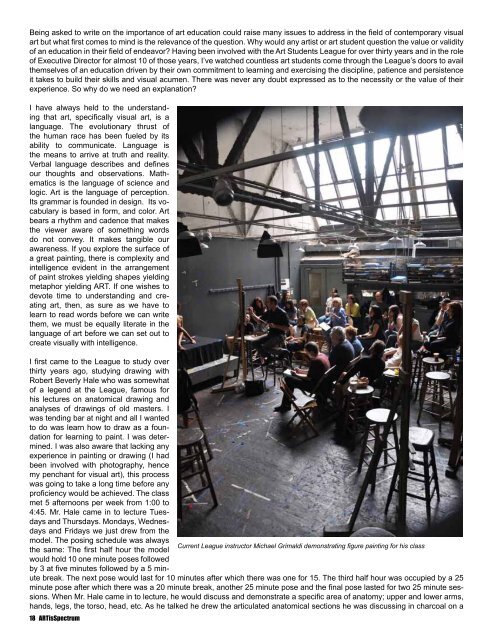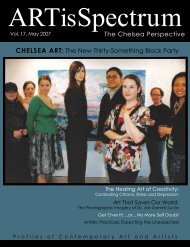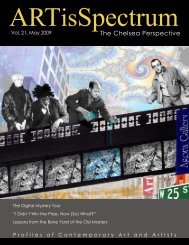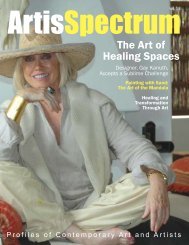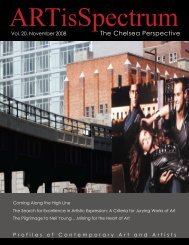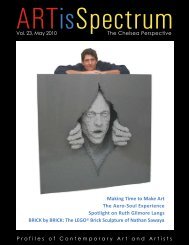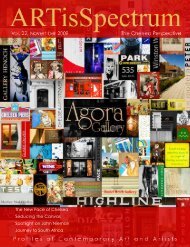Profiles of Contemporary Art and - ARTisSpectrum
Profiles of Contemporary Art and - ARTisSpectrum
Profiles of Contemporary Art and - ARTisSpectrum
You also want an ePaper? Increase the reach of your titles
YUMPU automatically turns print PDFs into web optimized ePapers that Google loves.
Being asked to write on the importance <strong>of</strong> art education could raise many issues to address in the field <strong>of</strong> contemporary visual<br />
art but what first comes to mind is the relevance <strong>of</strong> the question. Why would any artist or art student question the value or validity<br />
<strong>of</strong> an education in their field <strong>of</strong> endeavor? Having been involved with the <strong>Art</strong> Students League for over thirty years <strong>and</strong> in the role<br />
<strong>of</strong> Executive Director for almost 10 <strong>of</strong> those years, I’ve watched countless art students come through the League’s doors to avail<br />
themselves <strong>of</strong> an education driven by their own commitment to learning <strong>and</strong> exercising the discipline, patience <strong>and</strong> persistence<br />
it takes to build their skills <strong>and</strong> visual acumen. There was never any doubt expressed as to the necessity or the value <strong>of</strong> their<br />
experience. So why do we need an explanation?<br />
I have always held to the underst<strong>and</strong>ing<br />
that art, specifically visual art, is a<br />
language. The evolutionary thrust <strong>of</strong><br />
the human race has been fueled by its<br />
ability to communicate. Language is<br />
the means to arrive at truth <strong>and</strong> reality.<br />
Verbal language describes <strong>and</strong> defines<br />
our thoughts <strong>and</strong> observations. Mathematics<br />
is the language <strong>of</strong> science <strong>and</strong><br />
logic. <strong>Art</strong> is the language <strong>of</strong> perception.<br />
Its grammar is founded in design. Its vocabulary<br />
is based in form, <strong>and</strong> color. <strong>Art</strong><br />
bears a rhythm <strong>and</strong> cadence that makes<br />
the viewer aware <strong>of</strong> something words<br />
do not convey. It makes tangible our<br />
awareness. If you explore the surface <strong>of</strong><br />
a great painting, there is complexity <strong>and</strong><br />
intelligence evident in the arrangement<br />
<strong>of</strong> paint strokes yielding shapes yielding<br />
metaphor yielding ART. If one wishes to<br />
devote time to underst<strong>and</strong>ing <strong>and</strong> creating<br />
art, then, as sure as we have to<br />
learn to read words before we can write<br />
them, we must be equally literate in the<br />
language <strong>of</strong> art before we can set out to<br />
create visually with intelligence.<br />
I first came to the League to study over<br />
thirty years ago, studying drawing with<br />
Robert Beverly Hale who was somewhat<br />
<strong>of</strong> a legend at the League, famous for<br />
his lectures on anatomical drawing <strong>and</strong><br />
analyses <strong>of</strong> drawings <strong>of</strong> old masters. I<br />
was tending bar at night <strong>and</strong> all I wanted<br />
to do was learn how to draw as a foundation<br />
for learning to paint. I was determined.<br />
I was also aware that lacking any<br />
experience in painting or drawing (I had<br />
been involved with photography, hence<br />
my penchant for visual art), this process<br />
was going to take a long time before any<br />
pr<strong>of</strong>iciency would be achieved. The class<br />
met 5 afternoons per week from 1:00 to<br />
4:45. Mr. Hale came in to lecture Tuesdays<br />
<strong>and</strong> Thursdays. Mondays, Wednesdays<br />
<strong>and</strong> Fridays we just drew from the<br />
model. The posing schedule was always<br />
Current League instructor Michael Grimaldi demonstrating figure painting for his class<br />
the same: The first half hour the model<br />
would hold 10 one minute poses followed<br />
by 3 at five minutes followed by a 5 minute<br />
break. The next pose would last for 10 minutes after which there was one for 15. The third half hour was occupied by a 25<br />
minute pose after which there was a 20 minute break, another 25 minute pose <strong>and</strong> the final pose lasted for two 25 minute sessions.<br />
When Mr. Hale came in to lecture, he would discuss <strong>and</strong> demonstrate a specific area <strong>of</strong> anatomy; upper <strong>and</strong> lower arms,<br />
h<strong>and</strong>s, legs, the torso, head, etc. As he talked he drew the articulated anatomical sections he was discussing in charcoal on a<br />
18 <strong>ARTisSpectrum</strong>


